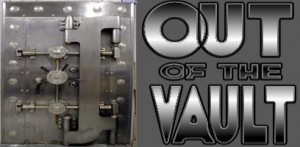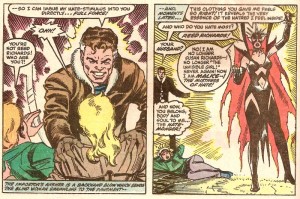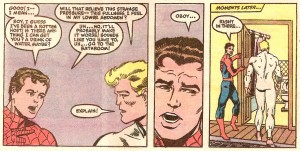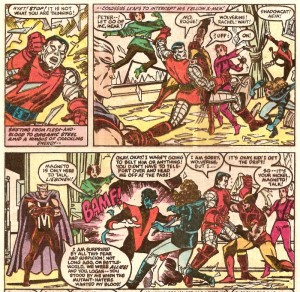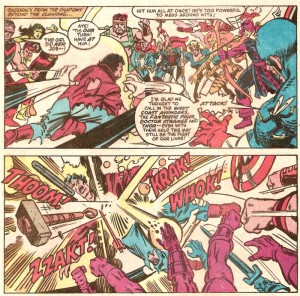 Through the 70’s and into the 80’s, I was a Marvel fan. I came to Marvel late in my childhood, having been more a DC kid when I was younger. Maybe that explains why I ended up abandoning Marvel long before I gave up on DC.
Through the 70’s and into the 80’s, I was a Marvel fan. I came to Marvel late in my childhood, having been more a DC kid when I was younger. Maybe that explains why I ended up abandoning Marvel long before I gave up on DC.
The other reason is that Marvel put out shit like Secret Wars II.
As should be apparent from the title, Secret Wars II was the sequel to Secret Wars, or more properly, Marvel Super Heroes Secret Wars. Secret Wars was perhaps the first official comics-universe-wide crossover event. Marvel had flirted with similar ideas in the past, with miniseries like Contest of Champions featuring nearly all of their major heroes (but not crossing over into their books), or events like the demon invasion in Walt Simonson’s Thor run crossing over into the storylines of basically every New York-based hero.
Secret Wars was more ambitious than that. Secret Wars (which I’ll discuss in more detail next week–yes, I’m working backwards) was a year-long miniseries which detailed the events which caused huge changes in the storylines of most of Marvel’s major books. It was a huge success, which is why less than a year after it ended, Marvel rushed out a sequel.
Scripted by Jim Shooter (Marvel’s then editor-in-chief and also the writer of Secret Wars) and drawn by Al Milgrom, Secret Wars II featured the cosmic entity known as the Beyonder coming to Earth to learn more about the people he’d kidnapped in the first series. His initial human form is an amalgam of the costumes of several of the folks who participated in the Beyonder’s contest.
As the series progresses, he tries to learn what it means to be human. Each issue would present the Beyonder grappling with the philosophical issues behind human existence. So for instance, in issue 3, the Beyonder learns about desire, and in issue 4, he learns about love (by falling in love with Dazzler, of all people, in another desperate attempt to make that ill-conceived character interesting and relevant). This makes it sound as if Secret Wars II had some sort of literary pretensions, like a comics version of Huck Finn or something.
Which maybe it did, except that it was unfortunately not a novel, but a comic book written by Jim Shooter, who could never be accused of subtlety. Even worse, it was a comic book whose apparent purpose was to tie in with every single other series Marvel put out, hoping to spread some of that original Secret Wars sales magic to other, lesser-performing books.
Unlike the original Secret Wars, which was a self-contained story happening far away from the rest of the Marvel Universe and whose effects on the tie-in books happened all at once, Secret Wars II took place in New York concurrent with the rest of the line. So, for instance, in issue 2, when the Beyonder encounters events happening in that month’s Fantastic Four, you get scenes like this.
If you didn’t read Fantastic Four, this would make no sense to you. The hope was that this would prompt you to buy Fantastic Four to learn the rest of the story. But seriously, the teaser is so poorly executed that I can’t see anyone who wasn’t already buying John Byrne’s much superior series being convinced to try based on this crappy, random excerpt.
Another guest crossing over in issue 2 was the Amazing Spider-Man, who would be beating up Firelord in his own book not long after (as detailed in last week’s Out of the Vault). The Beyonder decided to ask Spider-Man what being human was all about, which led to one of the most awkward scenes ever to appear in a comic book.
And I get that it’s supposed to be whimsical and funny, but man, it’s just badly done. Even worse, though, were the scenes crossing over to group books, because then Shooter would have to write dialogue to introduce all the characters.
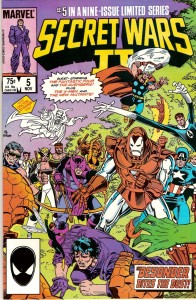 This is somehow even clumsier than his attempts to do the same thing in the first Secret Wars. As the series progressed, the storytelling got even more fragmented. The Beyonder would decide to visit someone, disappear, and appear in the next panel saying, “Wow, that was a mistake,” with a little message in the bottom of the panel telling you to read whatever book it was to find out the full story.
This is somehow even clumsier than his attempts to do the same thing in the first Secret Wars. As the series progressed, the storytelling got even more fragmented. The Beyonder would decide to visit someone, disappear, and appear in the next panel saying, “Wow, that was a mistake,” with a little message in the bottom of the panel telling you to read whatever book it was to find out the full story.
But geez, why would you? The Beyonder was just a boring character. He could do literally anything, and he had no purpose and no personality, because he started out as a blank slate. And a blank slate can be fascinating if done well, as in the movie Being There, but it requires a deft touch and interesting characters for the blank slate to play off of, and Shooter provided neither of these.
As the book progressed, it seemed to become ever more desperate to maintain interest, mainly by having a series of ever-more-perfunctory fights. The Beyonder would appear, somebody would shout, “Get him!”, and there would be a dogpile.
And at this point, Shooter has stopped even trying to make the dialogue seem at all natural, just turning the dialogue balloon into a laundry list of the characters appearing in this panel. This scene is from issue 5, the cover to which appears just above, where you’ll notice Doctor Strange gets a special mention with an arrow pointing at him.
If you think that means Doctor Strange will play some special part in the story, you would be mistaken. After his brief namecheck in the panel above, he appears in the background of the fight along with twenty other heroes, then gets one line of inconsequential dialogue before the issue ends. And somehow, this was supposed to get people to want to buy his series?
The entire thing was a misfire, from start to finish (I’m guessing, because I never got to the finish). And worse, because Shooter was editor-in-chief, the entire Marvel line was suffering from this kind of mindset. Even books I had previously liked, like Uncanny X-Men and Amazing Spider-Man, were getting tired and convoluted. I dropped Secret Wars II after 5 issues, and dropped the entire Marvel line not much later.

